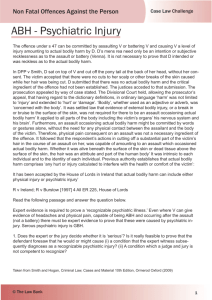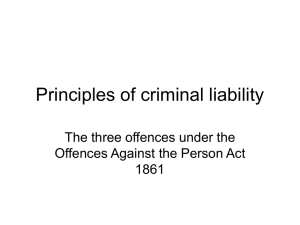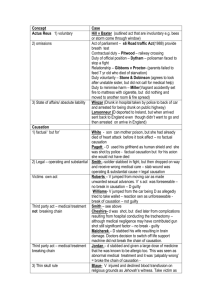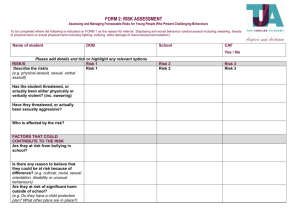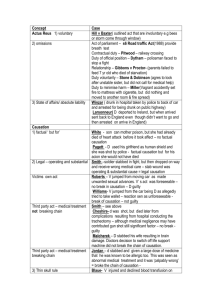non fatal ofences
advertisement
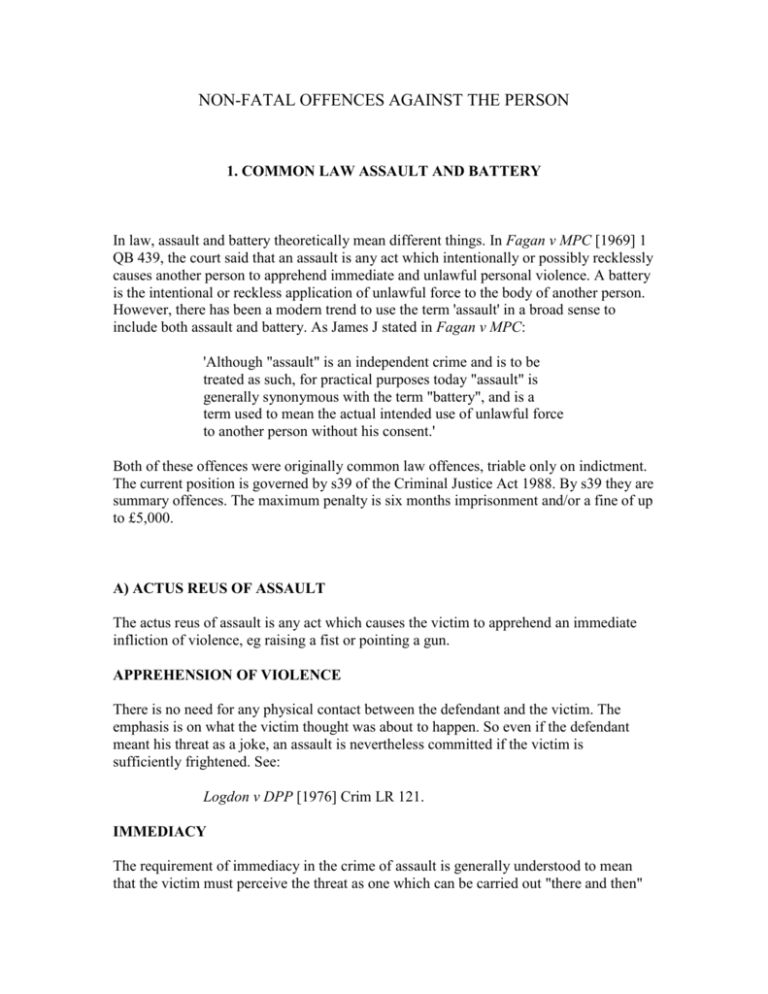
NON-FATAL OFFENCES AGAINST THE PERSON 1. COMMON LAW ASSAULT AND BATTERY In law, assault and battery theoretically mean different things. In Fagan v MPC [1969] 1 QB 439, the court said that an assault is any act which intentionally or possibly recklessly causes another person to apprehend immediate and unlawful personal violence. A battery is the intentional or reckless application of unlawful force to the body of another person. However, there has been a modern trend to use the term 'assault' in a broad sense to include both assault and battery. As James J stated in Fagan v MPC: 'Although "assault" is an independent crime and is to be treated as such, for practical purposes today "assault" is generally synonymous with the term "battery", and is a term used to mean the actual intended use of unlawful force to another person without his consent.' Both of these offences were originally common law offences, triable only on indictment. The current position is governed by s39 of the Criminal Justice Act 1988. By s39 they are summary offences. The maximum penalty is six months imprisonment and/or a fine of up to £5,000. A) ACTUS REUS OF ASSAULT The actus reus of assault is any act which causes the victim to apprehend an immediate infliction of violence, eg raising a fist or pointing a gun. APPREHENSION OF VIOLENCE There is no need for any physical contact between the defendant and the victim. The emphasis is on what the victim thought was about to happen. So even if the defendant meant his threat as a joke, an assault is nevertheless committed if the victim is sufficiently frightened. See: Logdon v DPP [1976] Crim LR 121. IMMEDIACY The requirement of immediacy in the crime of assault is generally understood to mean that the victim must perceive the threat as one which can be carried out "there and then" by the defendant. The courts have on occasion however, given a somewhat liberal interpretation to the concept of immediacy in assault. Compare: Smith v Superintendent of Woking Police Station [1983] Crim LR 323 R v Arobieke [1988] Crim LR 314. CAN MERE WORDS CONSTITUTE AN ASSAULT? The case of R v Meade and Belt (1823) 1 Lew CC 184, where Holyroyd J stated that "no words or singing are equivalent to an assault", is often cited as authority for the proposition that words alone, unaccompanied by physical gestures, cannot amount to an assault. There is however, evidence to contradict this view of the law: · According to Clarkson and Keating, Criminal Law (3rd ed, 1994), the better view is that words alone can constitute an assault, provided they threaten a sufficiently immediate use of force. See also Smith & Hogan, Criminal Law (8th ed, 1996) p414-5. · The House of Lords recently stated that an assault can be committed by words alone in R v Ireland [1997], and the Court of Appeal in R v Constanza [1997] (below). · Note also the possibility of public order offences and the offence of making threats to kill. What is clear is that words will not constitute an assault if they are phrased in such a way that negatives any threat that the defendant is making. See: Tuberville v Savage (1669) 2 Keb 545. B) MENS REA OF ASSAULT The defendant must intentionally or recklessly cause his victim to apprehend the infliction of immediate force (R v Venna [1976] QB 421). In R v Spratt [1990] 1 WLR 1073, the Court of Appeal held that the subjective Cunningham test of recklessness applies here, in that the defendant had to be aware of the risk of causing another person to apprehend harm. C) ACTUS REUS OF BATTERY A battery is the infliction of unlawful force by one person upon another. The least touching of another will suffice: Cole v Turner (1705) 6 Mod 149. In Wilson v Pringle [1986] 2 All ER 440, the Court of Appeal (Civil Division) held that for a battery the "touching must be proved to be a hostile touching". This seems to have been accepted by the House of Lords in R v Brown [1993] 2 All ER 75 (if an act was unlawful it was hostile). However, certain forms of contact are regarded as an unavoidable and generally accepted consequence of social intercourse and therefore not actionable: casual jostling in a busy street or shop; touching someone to engage his attention; a congratulatory slap on the back; all are treated as acceptable if kept within reasonable bounds (Cole v Turner; Tuberville v Savage; Collins v Wilcock [1984] 3 All ER 374). D) MENS REA OF BATTERY In R v Venna [1976] QB 421, James J stated "the element of mens rea in the offence of battery is satisfied by proof that the defendant intentionally or recklessly applied force to the person of another". Recklessness here bears its subjective Cunningham meaning. 2. ASSAULT OCCASIONING ACTUAL BODILY HARM Section 47 of the Offences Against the Person Act 1861 provides that: "Whosoever shall be convicted on indictment of any assault occasioning actual bodily harm shall be liable … to be imprisoned for any term not exceeding five years." Such a charge is triable either way and punishable with a maximum of five years' imprisonment on conviction on indictment. A) ACTUS REUS The actus reus of the offence is (a) an assault, ie any act which causes the victim to apprehend an immediate infliction of violence or the actual infliction of violence (b) occasioning (c) bodily harm. OCCASIONING The word 'occasioning' as used in s47 can be taken to mean the same as 'causing', in that it must be shown that the defendant's actions have caused the bodily harm. The test that should be applied to determine whether the defendant was the cause in law of the victim's injury was explained by the Court of Appeal in: R v Roberts (1971) 56 Cr App R 95. This view was confirmed by the House of Lords in R v Savage; DPP v Parmenter [1991] (see below). ACTUAL BODILY HARM The meaning of 'actual bodily harm' was explained by the Court of Appeal in: R v Chan-Fook [1994] 2 All ER 552. The House of Lords recently upheld the decision of the Court of Appeal that a telephone call or a series of telephone calls, followed by silence, could constitute an assault causing actual bodily harm: R v Ireland [1997] 4 All ER 225. Stalking may also amount to an assault occasioning actual bodily harm, where it causes a clinical illness (as opposed to simple anxiety and stress). See: R v Constanza [1997] Crim LR 576. The problem of stalking has now been dealt with in the Protection From Harrassment Act 1997 (which came into force on 16 June 1997). B) MENS REA Liability is established if the defendant has the mens rea of common assault (intention or recklessness). No mens rea at all is required as to causing actual bodily harm. All that need be proved is the causal link between the assault and the harm. See: R v Savage; DPP v Parmenter [1991] 4 All ER 698. 3. MALICIOUSLY WOUNDING OR MALICIOUSLY INFLICTING GRIEVOUS BODILY HARM Section 20 of the Offences Against the Person Act 1861 states that: "Whosoever shall unlawfully and maliciously wound or inflict any grievous bodily harm upon any person, either with or without any weapon or instrument, shall be guilty of an offence, and being convicted thereof shall be liable to imprisonment for five years." This offence is triable either way and punishable on conviction on indictment with a maximum of five years' imprisonment. A) ACTUS REUS MALICIOUS WOUNDING Wounding requires there to have been a break in the surface of the skin. Note the following technical points: * Both the dermis and the epidermis must be broken (Moriarty v Brooks (1834) 6 C & P 684). * A scratch or break to the outer skin is not sufficient if the inner skin remains intact (M'Loughlin (1838) 8 C & P 635). * An internal rupture of blood vessels in the victim's eyes will not amount to wounding within s20 (JCC (A Minor) v Eisenhower (1984) 78 Cr App R 48). A defendant in such a case might, however, still be guilty of actual bodily harm (s47), or even grievous bodily harm (s20) in extreme cases. GRIEVOUS BODILY HARM Grievous bodily harm was defined by the House of Lords in DPP v Smith [1961] AC 290 as meaning nothing more technical than "really serious bodily harm". The Court of Appeal has since held, in R v Sanders [1985] Crim LR 230, that it is sufficient for a trial judge to direct a jury that grievous bodily harm simply means "serious harm". According to Dugdale and Furmston, 'A' Level Law (2nd Ed, 1992) p308, any injury serious enough to warrant hospital treatment will be regarded as serious, such as broken bones, cuts requiring stitches, ruptures of internal organs, etc. INFLICT The term "inflict" should generally be treated as simply requiring proof of causation. Grievous bodily harm may be inflicted directly or indirectly. See: R v Martin (1881) 8 QBD 54. R v Wilson [1984] AC 242. It was also said in R v Wilson that a s20 charge did not necessarily have to include an allegation of assault (although almost all would). The House of Lords recently upheld the decision of the Court of Appeal that a "stalker" could be convicted of an offence of unlawfully and maliciously inflicting grievous bodily harm, contrary to s20, even where he had not applied physical violence directly or indirectly to the body of the victim. See: R v Burstow [1997] 4 All ER 225. B) MENS REA The mens rea required is denoted by the word 'maliciously'. In order to prove that the defendant acted maliciously, it is sufficient to prove that he intended his act to result in some unlawful bodily harm to some other person, albeit of a minor nature, or was subjectively reckless as to the risk that his act might result in such harm. See: R v Mowatt [1968] 1 QB 421. This was approved by the House of Lords in R v Savage; DPP v Parmenter [1991]. Consequently, a defendant could now be guilty of the offence if he punches a victim foreseeing that he might cause bruising, but actually cuts his face with the force of the blow. However, the defendant must foresee the possibility of some physical harm occurring or he will not be liable under s20. See: R v Savage; DPP v Parmenter [1991] 4 All ER 698. On the same principle, an intention merely to frighten will not be sufficient for this offence. See: R v Sullivan [1981] Crim LR 46. 4. MALICIOUSLY WOUNDING OR CAUSING GRIEVOUS BODILY HARM WITH INTENT Section 18 of the Offences Against the Person Act 1861 provides: "Whosoever shall unlawfully and maliciously by any means whatsoever wound or cause any grievous bodily harm to any person, with intent to do some grievous bodily harm to any person, or with intent to resist or prevent the lawful apprehension or detainer of any person, shall be guilty of an offence, and being convicted thereof shall be liable to imprisonment for life." This offence is triable only on indictment. A) ACTUS REUS The actus reus of the offence, either maliciously wounding or causing grievous bodily harm, is the same as under s20 (above). With regard to the word "causing", the House of Lords in R v Mandair [1994] 2 All ER 715, held that "causing" was "wider or at least not narrower than the word 'inflict'." B) MENS REA The defendant must be 'malicious' (see above under s20) but in addition he must be proved to have had a further specific intent, in that it must have been the defendant's intention (1) to do some grievous bodily harm to the victim, or (2) to resist or prevent a lawful arrest or detention. See: R v Belfon [1976] 1 WLR 741. CHARGING STANDARDS Following the publication in June 1994, of the revised Code for Crown Prosecutors, the Police and the CPS have co-operated in the development of charging standards on (nonsexual and non-fatal) offences against the person to ensure greater consistency. See separate details.
